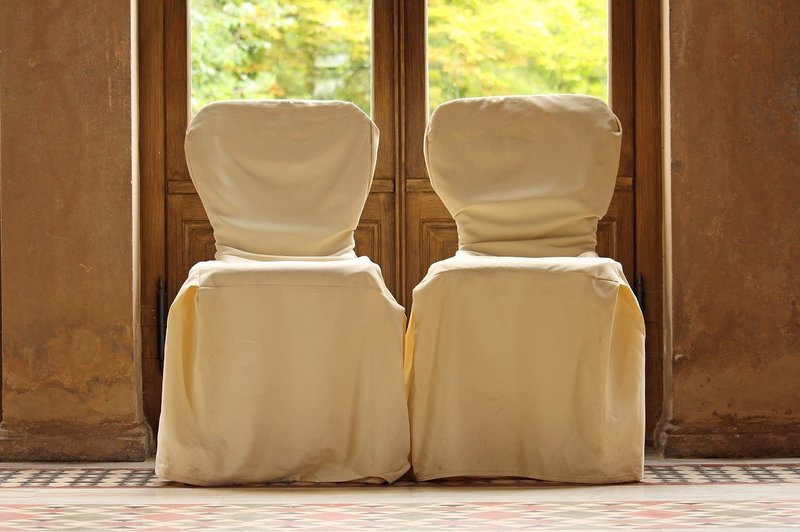Knowing how to make a chair slipcover without sewing is a cheap and easy way to decorate your home and protect your furniture at the same time. There is an easy but temporary way to make a chair cover, which involves tucking a long blanket or fabric into the nooks of your chair. However, if you are feeling more creative, there is also a way to create a more permanent slipcover wherein you will need to measure, cut, and glue the fabric together.
Maybe you have excess fabric at home for recycling, or you just want to improve the ambiance of your home. Either way, making chair slipcovers is a great way to do both at the same time. Continue reading to learn how to make your very own DIY chair slipcovers — all without sewing!

Creating A Chair Slipcover Without Sewing
Chair slipcovers or loose covers are “slipped” on and off the chairs in order to protect them from dust, sunlight, humidity, and the like. The best way to create a durable slipcover is to tailor-make them for your chair. However, it is possible to make one without sewing.
Method #1. Tucking in a long fabric
The tucking method is best for those that want a temporary slipcover for an event or for visitors. For this method, all you will need is a piece of fabric big enough to cover your chair but small enough not to spread all over the floor.
First, put your fabric or blanket on top of the chair. Make sure that the corners hang at almost equal lengths over the legs of the chair.
Take two ends of cloth from the backside of the chair and tie them into a knot. This knot holds the excess fabric in place.
After spreading the cover over the chair and tying the knot, tuck the fabric into the corners and crevices of the chair. Smooth and even out the fabric over the chair.
If you want to, you can use safety pins to secure the cover onto the chair. Place the safety pins on the corners of the cushioning.
After use, you can just undo the knots and place the fabrics into the washer for cleaning.
Method #2. Making a complete cover from scratch
This method of creating slipcovers needs fabrics, multiple safety pins, scissors, a pencil, and fabric glue. For beginners, it is best to use a plain, solid color fabric.
Step #1. Take a piece of fabric and place it on the front of your chair’s arm. Pin it onto your chair using a safety pin.
Trace the outline of the front of your chair’s arms, leaving a 1-inch seam allowance. Afterward, label the fabrics with a pencil. Take the materials off the chair and cut off your outline.
Step #2. Place another piece of fabric onto the seat of your chair, letting it hang off to the base. Tuck in the excess fabrics under the seat cushion and then attach them to the chair using safety pins. Cut off any extra cloth at the bottom of the chair.
Step #3. Repeat the pinning, outlining, and labeling process over the back, arms, and sides. Cut off any excess fabrics but leave a one-inch seam allowance to ensure a perfect fit.
Once every piece is labeled and cut, pin everything back to the chair. Attach the front of the arms first, then the ones over the arms and sides, and then the back.
Step #4. From here, you have two options — you can either attach the fabrics onto the chair itself, or you can opt to glue only the fabrics together. The latter option allows you to remove the slipcover while the former attaches it onto the chair permanently.
Either way, once everything is pinned securely onto the chair, you can start gluing them together. Fold the allowances on the arms and back underneath the fabric so that it appears smooth and seamless. Once every corner is glued together, allow it to dry for a few hours.
Step #5. When you choose to go the permanent route, you can add fabric glue to the pieces and attach them to the chair itself, ensuring a perfect hold. However, remember that this may be irreversible and that the slipcover may not be removed without damaging the chair’s fabric.
Step #6. When the glue is completely dry, remove the pins. The chair slipcover is complete at this point. However, you can add decorative cords over the sides where the fabrics meet.
The decorative cords will serve as piping, hiding any raw edges and giving the cover a more three-dimensional look. You can also pin fringes around the base of the slipcover and glue it. Once the glue dries, you can remove the pins.
Conclusion
Learning how to make a chair slipcover without sewing is a fantastic way to reuse old fabrics, protect furniture, and decorate your home all at the same time. All you need to create loose covers are fabrics, adhesives, scissors, and some knowledge. Although it takes a lot of time, patience, and effort, the result will give you something that visitors will talk about for years to come.
